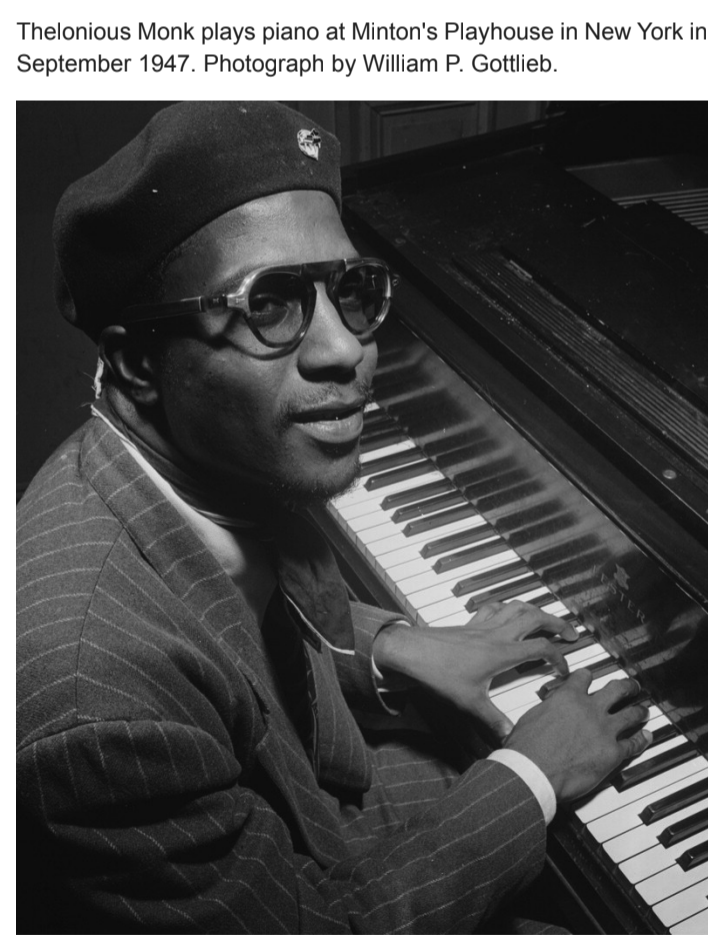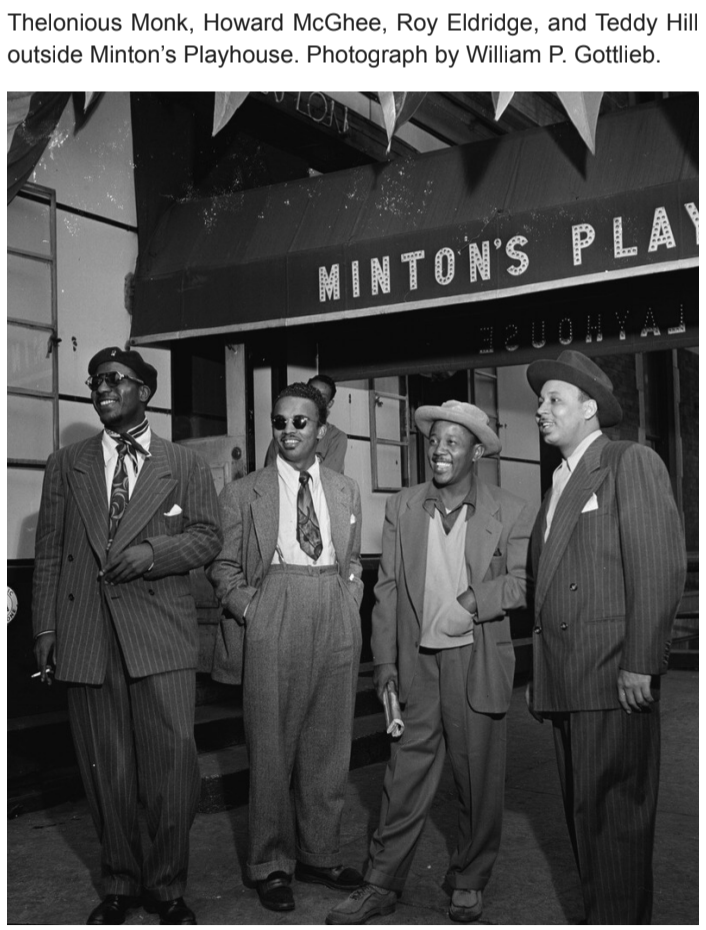A new style of jazz began to emerge in New York City during the mid-1940s, dubbed “bebop” by its pioneers. With its trademark flurry of complicated melodic lines, bebop is the musical equivalent of receiving every dish on the menu at once. It dismantled the danceable swing style of the prior era’s jazz; the music became fast, involved, and abstruse.
The epicenter of the bebop movement was Minton’s Playhouse, a compact Harlem nightclub. Musicians did not so much patronize Minton’s as rely on it for subsistence. And among the favored musicians at Minton’s, performing in the smoky den for a clientele equal parts eccentric and drug-hazed, was Thelonious Monk. Any given evening at Minton’s, Monk could be found at the piano, nurturing a cigarette between his teeth.
Like that of any other bebop musician, Monk’s playing was characterized by a central facet: improvisation. In contrast with current popular music heard on the radio or a Mozart composition, the music played by bebop musicians is made up on the spot—ex tempore. As if following a map marked only with a start and an end, the musicians have an idea of where they are and where they want to go, but they have no set path for how to get there.
At the time, Monk and his contemporaries seemed set to be painted onto the mural of modern music as an inconsequential afterthought. In contrast to the popular acts of the era, bebop musicians had neither the polished image of Perry Como nor the endearing choruses of Frank Sinatra. Bebop was not the kind of music one might expect the typical post-war American to enjoy.
Yet, despite bebop’s gratuitous nonconformity, its innovators became icons of American artistry. Among many other accolades, Monk won a Pulitzer Prize and a Grammy Lifetime Achievement Award. Monk is the second most recorded jazz composer of all time—an achievement that is made more impressive when contrasted with how few songs he actually composed. The most recorded jazz composer of all time, Duke Ellington, penned over 1,000 songs; Monk composed only 70.
Though Monk’s status as a figure of American music may be curious, this story contains a more intriguing phenomenon: that Monk and his colleagues could play this music in the first place. Bebop musicians created art characterized by its spontaneity while being produced at the fastest speeds physically allowed by a musical instrument. Somehow improvisers used this manic, abstract music to create meaningful works of art.
How can the human brain produce jazz improvisation?
Neural Correlates of Improvised Music
Intrigued by this question, Johns Hopkins neurologists Charles Limb and Allen Braun sought to find out which areas of the brain activate in improvising musicians. Limb and Braun recruited six professional jazz pianists—contemporary Monks—for a functional magnetic resonance imaging experiment. Limb and Braun faced the challenge of trying to maximize scientific precision while recreating the authentic experience of a musician as closely as possible. Trading the dimly lit stage at Minton’s for the sterile, white confines of an MRI scanner required some ingenuity. To address this issue, Limb and Braun designed a special keyboard that would be safe in a powerful magnetic field while still allowing the musicians to retain a realistic feeling of playing. With this keyboard, the pianists played a sequence of songs, some of which were memorized and some of which were spontaneously composed. The only difference between the two situations was whether or not the musicians improvised. The variation between these brain states showed which areas activated specifically for improvisation, beyond what was required simply to play piano (Limb & Braun, 2008).
Limb and Braun’s first finding may have elicited an I-could-have-told-you-that response from Monk. They found deactivation in areas of the brain that are thought to be concerned with what society will think about one’s actions. Two particular brain areas perk up when you know the world is watching and choose to act according to societal conventions; they are known as the dorsolateral prefrontal cortex and the lateral orbitofrontal cortex. For Monk, who frequently danced around on stage when tired of the piano, deactivation of these areas was commonplace: “I say, play your own way. Don’t play what the public wants.”
Limb and Braun’s second finding was more intriguing: Jazz improvisation activates a region of the brain that Braun and his colleagues had previously hypothesized is responsible for parsing narrative structure (Xu et al., 2005). This area is known as the medial prefrontal cortex. Further scrutiny is required to substantiate their hypothesis, but preliminary evidence suggests that the medial prefrontal cortex contributes to how one naturally tends to tell a story with a beginning, middle, and end. This brain region is key to understanding how the brain creates jazz improvisation.
Neurological Similarities Between Improvised Music and Language
Monk played his solos much like he would tell a story. He would present an initial musical idea; tinker with the details of that idea, expanding on its key points; then present a conclusion—as if asking for your opinion. The narrative unfolds fluently even though he is making this story up as he goes. A drummer and bassist would have accompanied him, not as passive audience members, but as confidants responding in earnest to Monk’s ideas.
Compare this interaction among the members of Monk’s band with a conversation you would have with a friend, requiring attentive participation from you both. Your conversation and Monk’s improvisation are remarkably similar. Both have basic narrative structure of exposition, development, and conclusion. Both relate complex information without premeditation. Both require empathetic interaction among participants.
This is not just a qualitative observation: Musical improvisation and spoken language are processed similarly in the brain. The medial prefrontal cortex activation that Limb and Braun saw in improvising musicians is the same region would also likely be activated if you were telling a story to a friend. It appears that the brain uses some of the same regions to develop narrative structure in both improvised music and conversation.
Charles Limb and a team of his students, led by Gabriel Donnay, ran another jazz-inspired functional imaging study. This time, they looked at improvisational interaction. Unsurprisingly, there is already an established paradigm in jazz to facilitate conversation-like interaction called trading, in which improvisers trade short musical phrases back and forth in response to one another. Donnay and his team used the same method of comparing improvisation with non-improvisation as before, but this time they scanned each subject while trading with another musician (Donnay et al., 2014).
Donnay and his team found a pattern of activation that decidedly resembles what happens in the brain while participating in conversational language. Most notably, they saw activation in an area concerned with structure of a different kind, of sentences rather than of narratives. This area, called the inferior frontal gyrus, or Broca’s area, helps distinguish between “dog bites man” and “man bites dog”.
Harvard neurologists Aaron Berkowitz and Daniel Ansari showed that this pattern of activation is not just the case for musical improvisation in jazz, but also for improvisation in classical music. Instead of studying the brains of jazz musicians, they examined classical pianists’ brains in the same improvisation-versus-non-improvisation setup. Berkowitz and Ansari found that improvisational activations in classical musicians overlapped significantly with those observed in jazz musicians (Berkowitz & Ansari, 2008).
Siyuan Liu, a student of Allen Braun, furthered these improvisational functional imaging findings by studying the brains of freestyle rappers while performing a lyrical improvisation or a composed verse. He found that the main difference between improvised and rehearsed rap was activation in the same narrative structure region as between improvised and rehearsed jazz, the medial prefrontal cortex (Liu et al., 2012).
Neurological Differences Between Improvised Music and Language
The brain is clearly using similar neurological mechanisms when producing musical improvisation as when producing language. The first kind of mechanism, in the medial prefrontal cortex, supports narrative structure. Musical narrative structure suggests how a given musical phrase fits into the overall story—gradually introducing tension and building to a resolution. The second kind of mechanism, in the inferior frontal gyrus, supports phrase structure. Musical phrase structure suggests how certain notes and rhythms would fit in the context of the previously played notes and rhythms.
But where exactly is the line drawn between improvised music and language in the brain?

Intuitively, one might suspect that although the structural elements of music and language are similar, different strategies are used to assign meaning to them. For example, following an A with an E flat in the key of C would be unlikely in the same way that following “apple” with “are” would be unlikely in English. However, the way in which we would interpret the meaning of those two events is completely different: “apple” refers directly to something in the world; the note A does not.
Steven Brown, a neuroscientist from the University of Texas, used positron emission tomography to show exactly that. He studied the brains of amateur musicians as they vocally improvised with either music or language. He found that the areas of the brain used for processing structure related to word or note ordering were largely the same, but that they occurred on different sides—language on the left, music on the right. The two kinds of improvisation did not appear to share any neurological real estate directly related to interpretation or meaning (Brown et al., 2006).
Brown’s findings suggest that the same kind of neurological machinery produces the structural elements of both musical and linguistic improvisation. Although the syntactic structure is processed similarly, whichever neurological machinery endows music with meaning does not require an ability to do the same for language. In other words, you do not need to speak English to speak jazz. Perhaps this effect is what an artist is referring to when she claims to express herself more truly with her medium than with language. She can articulate a story, but without being constrained by how literally meaning is assessed in language.
Donnay, Limb, and their colleagues supported Brown’s findings with their imaging study of trading. They observed the right hemisphere activation, which is key for music, but not language. However, they also observed musical improvisational activation in the language areas on the left side of the brain, which Brown thought activated exclusively for language. This suggests that not only do improvised music and language rely on some of the same kinds of neurological machinery, but that, as improvised music becomes increasingly conversational, the processing of musical structure increasingly resembles the processing of linguistic structure.
Interpretation of Musical Improvisation
A team of German music physiology researchers led by Eckhart Altenmüller used electroencephalography to compare brain activations with reported enjoyment of listening to certain songs. Participants listened to jazz, classical, and popular songs, then rated how much they liked each song. The best predictor of the listeners’ enjoyment of the music was lateralization of their brain activation. If the left prefrontal cortex activated more than the right, the listener probably enjoyed the song; if the right prefrontal cortex activated more than the left, then the listener probably did not enjoy the song. This was the case across all genres (Altenmüller et al., 2002).

They also found that people tended to like the popular songs, all of which had lyrics, more than the classical or jazz songs, of which none had lyrics. This means that enjoyment, lyrics, and left frontal cortex activation tended to appear together. The main exception to this trend is when participants reported enjoyment when listening to either classical or jazz. Their left frontal cortex activated even though there were no lyrics. While there are many plausible interpretations of these results, one possibility is that this left frontal cortex activation in the absence of lyrics is the brain’s attempt to impose narrative structure over the musical story. Those who successfully imposed the narrative structure enjoyed the music and experienced left frontal cortex activation; those who failed to impose narrative structure did not enjoy the music and showed no left frontal cortex activation.
Perhaps this explains how audiences began to enjoy Monk. They tapped into the story that Monk was telling and were able to interpret it for themselves.
This effect is similar to what happens when you know what someone is going to say before they say it. You can tell where the conversation is going, and you are tempted to finish the speaker’s thought before he gets there. When listening to jazz improvisation, your brain can pick up on that same anticipation of the next step. This anticipation draws you in to the musician’s story. When an artist employs his medial prefrontal cortex to create a melody that allows the listener to engage her own narrative voice, that is when improvised music elates us.
The enjoyment of bebop is not exclusive to the rakish lounges of 1940s New York. This phenomenon resonated throughout the world. Bebop festivals are now held in many major cities: from Cape Town to København, from Montréal to Monterrey. Regardless of mother tongue, people pick up on the storyline.
Though we can now begin to see how the brain makes musical improvisation possible, it does not diminish our perception of its artistic beauty. In fact, it expands the beauty of music by demonstrating the independence of improvised music from cultural boundaries. As Herbie Hancock, director of the Thelonious Monk Institute of Jazz, said: Music truly is the universal language.
References
- Limb, C. J., & Braun, A. R. (2008). Neural substrates of spontaneous musical performance: An fMRI study of jazz improvisation. PLoS One, 3(2), e1679.
- Xu, J., Kemeny, S., Park, G., Frattali, C., & Braun, A. (2005). Language in context: emergent features of word, sentence, and narrative comprehension. Neuroimage, 25(3), 1002-1015.
- Donnay, G. F., Rankin, S. K., Lopez-Gonzalez, M., Jiradejvong, P., & Limb, C. J. (2014). Neural substrates of interactive musical improvisation: an FMRI study of ‘trading fours’ in jazz. PloS one, 9(2), e88665.
- Berkowitz, A. L., & Ansari, D. (2008). Generation of novel motor sequences: the neural correlates of musical improvisation. Neuroimage, 41(2), 535-543.
- Liu, S., Chow, H. M., Xu, Y., Erkkinen, M. G., Swett, K. E., Eagle, M. W., ... & Braun, A. R. (2012). Neural correlates of lyrical improvisation: an fMRI study of freestyle rap. Scientific reports, 2.
- Brown, S., Martinez, M. J., & Parsons, L. M. (2006). Music and language side by side in the brain: a PET study of the generation of melodies and sentences. European journal of neuroscience, 23(10), 2791-2803.
- Altenmüller, E., Schürmann, K., Lim, V. K., & Parlitz, D. (2002). Hits to the left, flops to the right: different emotions during listening to music are reflected in cortical lateralisation patterns. Neuropsychologia, 40(13), 2242-2256.
